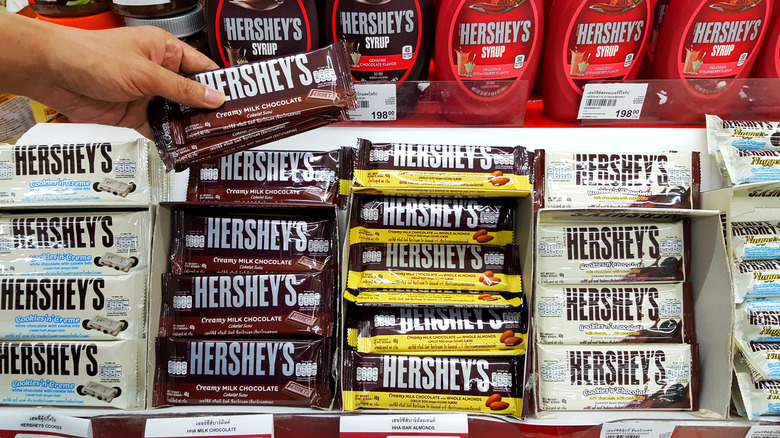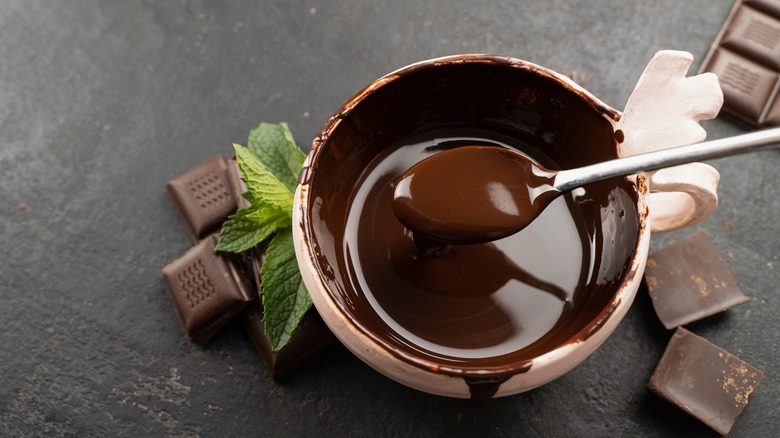The Scientific Reason Why Some Say American Chocolate Tastes Like Vomit
Among the many cultural disputes that exist between Americans and Europeans, the American chocolate debate is the stuff of legend. In case you're not aware, Europeans (along with many other citizens of the world), have very strong opinions about American chocolate and its questionable quality.
A Reddit thread featured on r/AskABrit poses this burning question to the public, and it's plain to see that non-Americans have lots to say about this country's chocolate offerings. A few choice quotes include, "I wouldn't eat it unless I was starving and there was no cardboard to eat," "It tastes terrible," and "To me it tastes (and I'm talking specifically about Hershey's I think) like sour/gone off milk." This last comment is particularly illuminating, as one of the most common complaints about chocolate manufactured in the U.S. is that it has the unsettling taste of vomit. According to one commenter, "It does taste of sick." As for the reasons behind this repulsive comparison, it's believed to result from the manufacturing process used for milk in the States.
Butyric acid: the ingredient no one warned you about
When it comes to distasteful American chocolate, Hershey's is an oft-derided brand that is said to exemplify the vomit flavor so many people around the world complain about. One accusation constantly leveled at the worldwide chocolate brand is the inclusion of butyric acid, a fatty acid found in foodstuffs like milk, butter, and parmesan cheese. Butyric acid is also a component of vomit, which lends quite a bit of credence to claims about American chocolate. In an effort to make milk last as long as possible, manufacturers can use a technique known as lipolysis. This process helps eliminate fatty acids in milk, which increases its lifespan. However, lipolysis also boosts the butyric acid content of milk, which may explain why certain types of chocolate feature an acrid, bitter flavor.
It must be said that Hershey's continually denies adding butyric acid to their chocolate. Despite these claims, it's possible that the substance is making an appearance in the brand's products thanks to lipolysis. Additionally, there are two other factors that can alter how chocolate tastes around the world.
The international chocolate wars rage on
As reported by BBC News, a former executive at Hershey's executive points to two possible reasons why American chocolate tastes different, in addition to variations caused by milk flavor. Lawrence Allen cites the portion of cocoa used to create the chocolate, as well as how long it takes to mix ingredients together. In the U.S., manufacturers of milk chocolate must include 10% non-fat cocoa powder, while in the European Union milk chocolate must contain 30% cocoa, which includes both non-fat cocoa powder and cocoa butter. It's true that some European chocolate companies make what's known as "family milk chocolate," which must contain 20% non-fat cocoa powder/butter and 20% milk solids (aka powdered milk).
As for the mixing process, ingredients used in higher-end chocolate brands are often mixed for a lot longer than in standard brands, including Hershey's. Lindt is a brand that's synonymous with sophistication, and these products have a mixing time of up to 12 hours. On the other hand, standard brands are usually mixed for one or two hours at a time. While these differences are likely to impact the flavor of chocolate, keep in mind that manufacturers are usually quite restrictive with their proprietary processes. That means it's challenging to identify the exact reason why chocolate tastes so different depending on where it's produced.


